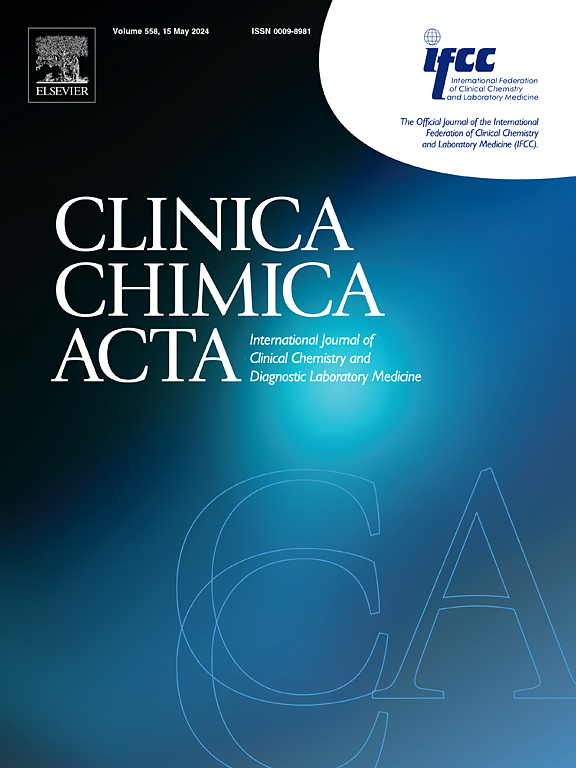The diagnostic accuracy of HE4 in the differential diagnosis of pleural effusions
IF 3.2
3区 医学
Q2 MEDICAL LABORATORY TECHNOLOGY
引用次数: 0
Abstract
Background
Pleural effusions are challenging to diagnose, with approximately 20–50% of malignant effusions not diagnosed by cytology. Human epididymal protein 4 (HE4) may be useful in the differential diagnosis of pleural effusions. In serum, this biomarker shows false-positive results in some benign diseases. The aim of this study was to evaluate the diagnostic utility of HE4 in this setting and to identify false positives.
Methods
Concentrations of HE4, adenosine deaminase, % polynuclear cells, and C-reactive protein, were determined in 238 pleural fluid samples and the estimated glomerular filtration rate (eGFr) in serum.
Results
HE4 values differed significantly (p < 0.01) between malignant [median (IQR)] [1065 (2085)] pmol/L and benign effusions [699 (589)] pmol/L. HE4 concentrations in gynecological and pulmonary tumors were significantly higher than in other tumors.
For a cut-off point of 3050 pmol/L, 22 % sensitivity and 100 % specificity were obtained.
In patients with benign disease, significant increases in HE4 were identified only in those with eGFr < 30 mL/min/1.73 m2 [1050(596)] pmol/L, and not in those with eGFr > 30 mL/min/1.73 m2 [597(532)] pmol/L).
Two cut-offs were established for maximum specificity, depending on the eGFr: 3050 pmol/L for eGFr < 30 mL/min/1.73 m2 and 1992 pmol/L for eGFr > 30 mL/min/1.73 m2. A sensitivity of 28.5 % was obtained for patients with eGFr > 30 mL/min/1.73 m2 and 36.3 % for patients with eGFr < 30 mL/min/1.73 m2. The sensitivity using a specific cut-off point was 29.7 %.
Conclusions
The determination of HE4 in pleural fluids demonstrates high specificity and low sensitivity. The use of specific cutoff points that are clinically adjusted improves sensitivity while maintaining maximum specificity.
HE4 在胸腔积液鉴别诊断中的诊断准确性。
背景:胸腔积液的诊断具有挑战性,约 20-50% 的恶性积液无法通过细胞学诊断。人类附睾蛋白 4(HE4)可能有助于胸腔积液的鉴别诊断。在血清中,该生物标志物在某些良性疾病中显示假阳性结果。本研究旨在评估 HE4 在这种情况下的诊断效用,并找出假阳性结果:方法:测定 238 份胸腔积液样本中 HE4、腺苷脱氨酶、多核细胞百分比和 C 反应蛋白的浓度,以及血清中肾小球滤过率(eGFr)的估计值:HE4 值差异显著(p 2 [1050(596)] pmol/L,eGFr > 30 mL/min/1.73 m2 [597(532)] pmol/L)。根据 eGFr 的不同,确定了两个最大特异性的临界值:eGFr 2 为 3050 pmol/L,eGFr > 30 mL/min/1.73 m2 为 1992 pmol/L。eGFr > 30 mL/min/1.73 m2 患者的灵敏度为 28.5%,eGFr 2 患者的灵敏度为 36.3%。采用特定截断点的灵敏度为 29.7%:结论:胸腔积液中 HE4 的测定显示出较高的特异性和较低的灵敏度。结论:胸腔积液中 HE4 的测定显示出高特异性和低敏感性,使用经临床调整的特定临界点可提高敏感性,同时保持最大特异性。
本文章由计算机程序翻译,如有差异,请以英文原文为准。
求助全文
约1分钟内获得全文
求助全文
来源期刊

Clinica Chimica Acta
医学-医学实验技术
CiteScore
10.10
自引率
2.00%
发文量
1268
审稿时长
23 days
期刊介绍:
The Official Journal of the International Federation of Clinical Chemistry and Laboratory Medicine (IFCC)
Clinica Chimica Acta is a high-quality journal which publishes original Research Communications in the field of clinical chemistry and laboratory medicine, defined as the diagnostic application of chemistry, biochemistry, immunochemistry, biochemical aspects of hematology, toxicology, and molecular biology to the study of human disease in body fluids and cells.
The objective of the journal is to publish novel information leading to a better understanding of biological mechanisms of human diseases, their prevention, diagnosis, and patient management. Reports of an applied clinical character are also welcome. Papers concerned with normal metabolic processes or with constituents of normal cells or body fluids, such as reports of experimental or clinical studies in animals, are only considered when they are clearly and directly relevant to human disease. Evaluation of commercial products have a low priority for publication, unless they are novel or represent a technological breakthrough. Studies dealing with effects of drugs and natural products and studies dealing with the redox status in various diseases are not within the journal''s scope. Development and evaluation of novel analytical methodologies where applicable to diagnostic clinical chemistry and laboratory medicine, including point-of-care testing, and topics on laboratory management and informatics will also be considered. Studies focused on emerging diagnostic technologies and (big) data analysis procedures including digitalization, mobile Health, and artificial Intelligence applied to Laboratory Medicine are also of interest.
 求助内容:
求助内容: 应助结果提醒方式:
应助结果提醒方式:


